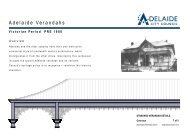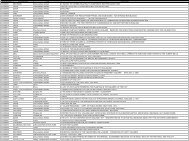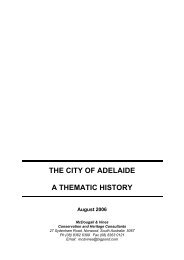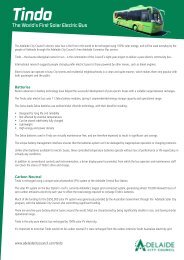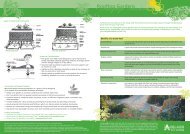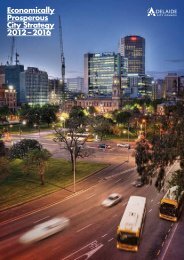Fact Sheet 4: Sound Insulation for Glazed Doors - Adelaide City ...
Fact Sheet 4: Sound Insulation for Glazed Doors - Adelaide City ...
Fact Sheet 4: Sound Insulation for Glazed Doors - Adelaide City ...
You also want an ePaper? Increase the reach of your titles
YUMPU automatically turns print PDFs into web optimized ePapers that Google loves.
FACT SHEET 4<br />
SOUND INSULATION FOR GLAZED DOORS AND STANDARD<br />
DOORS<br />
The sound insulation of glazed doors refers to the ability of a closed door to reduce noise<br />
entering your residence.<br />
The acoustic terminology used in this fact sheet is explained in <strong>Fact</strong> <strong>Sheet</strong> 11: Acoustic<br />
Terminology.<br />
Key Issues and Considerations<br />
When designing or modifying an external door, consideration should be given to the reduction<br />
of outside noise. Construction that reduces the ingress of external noise must be designed to<br />
ensure that it is integral with all other Building Rule requirements such as Energy Efficiency.<br />
If you are concerned about noise where you live, or are planning to renovate or purchase a<br />
house or apartment, you should consider the sound insulation of doors in your residence.<br />
<strong>Doors</strong> will provide an acoustic weakness to the external facade of a building as noise is<br />
transferred more easily through them than through the external walls. Improving the sound<br />
insulation of doors will help to reduce external noise ingress.<br />
Noise and <strong>Insulation</strong><br />
The Building Code of Australia (BCA) does not have sound insulation requirements <strong>for</strong> doors<br />
that open to the outside. Accordingly, it is important to consider your expectations regarding<br />
noise when choosing doors <strong>for</strong> your residence.<br />
The wide range of activity in the inner city generates higher levels of external noise than in<br />
suburban areas. Noise from activity such as traffic, people on the street, operational<br />
commercial sites and waste collection can adversely affect the amenity of those living in the<br />
<strong>City</strong>. As low frequency noise is particularly invasive, reducing the impact of noise from truck<br />
engines, buses, music etc may need to be considered. To effectively lower the amount of<br />
external noise that enters a building and subsequently maintain the amenity of an inner<br />
city residence, particular attention to the construction detail of the doors is required.<br />
Generally, the sound insulation properties of a door depend on the door’s composition and its<br />
seals.<br />
If you are considering any sound insulation, it is recommended you verify any sound<br />
insulation specifications with your architect/builder and/or employ the services of an acoustic<br />
consultant to ensure the proposed changes provide significant noise reduction.<br />
Other Per<strong>for</strong>mance Considerations<br />
The design of doors to reduce noise should be considered alongside thermal insulation<br />
requirements and the local environment. Consideration should also be given to other<br />
requirements such as vermin-proofing, and resistance to fire, smoke, chemicals, weather and<br />
dust.
<strong>Glazed</strong> <strong>Doors</strong><br />
FACT SHEET 4<br />
The ability of a window to reduce noise is dependent on the following elements:<br />
• frame design;<br />
• glazing;<br />
• composition of glass pane type; and<br />
• seals.<br />
Effect of Distance: The more distant the noise source, the lower the noise level. If you situate<br />
balconies away from a noise source, you can expect lower levels of noise.<br />
Effect of Height: On higher floors in a building, the street noise level is expected to decrease.<br />
General Acoustic Design of <strong>Glazed</strong> <strong>Doors</strong><br />
When choosing a glazed door to reduce noise, you should consider:<br />
• materials,<br />
• general construction, and<br />
• best practice design.<br />
Materials<br />
Frame<br />
There are several different materials commonly used <strong>for</strong> glazed door frames, however, the<br />
type of material does not usually have a significant influence on noise reduction properties.<br />
The installation of perimeter door seals is critical to the reduction of noise transfer via door<br />
frames.<br />
The door frame should be well sealed between the frame and the supporting wall as sound<br />
can flank around the frame when not properly fitted. This also improves thermal efficiency<br />
and prevents moisture ingress.<br />
Hinged doors are preferred to sliding doors as they are able to achieve a positive<br />
compression seal between the door and the frame. There are proprietary framing systems<br />
that provide improved acoustic per<strong>for</strong>mance.<br />
Door glazing - an example of single and double glazed frames<br />
Source: Titane Pty Ltd
Glazing<br />
FACT SHEET 4<br />
Source: <strong>City</strong> of Melbourne’s <strong>City</strong> <strong>Sound</strong>s2 Noise <strong>Fact</strong> <strong>Sheet</strong>s<br />
<strong>Glazed</strong> doors - an example of sliding and hinged type glazed frames<br />
There are a number of glazing options available:<br />
• Single glazing is the use of a single pane of glass in a window.<br />
• Double glazing is the use of two panes of glass in a window separated with a spacer.<br />
• Secondary glazing or retrofit double glazing is the use of two separate single glazed<br />
doors, where a second single pane is retrofitted to the inside of the existing exterior door<br />
to effectively double glaze the system.<br />
There is no single best method as each residence and situation is different. For example, the<br />
heritage status of a property or body corporate requirements may limit changes you can make<br />
to external doors, restricting options. Checking these factors and employing an acoustic<br />
consultant will guide you in selecting the best option <strong>for</strong> your residence.<br />
Glass Pane Type<br />
For single glazed doors, after appropriate sealing, the thickness of glass used is the major<br />
factor influencing the passage of sound after the seals. Typically, thicker glass offers better<br />
sound insulation than thinner glass, particularly when the major problem is low frequency<br />
noise such as truck engine or music noise. Toughened, coated, wired and patterned glass<br />
types behave acoustically the same as standard float glass.<br />
Laminated glass per<strong>for</strong>ms slightly better than other types of glass when the major problem is<br />
high frequency noise such as freeway traffic noise. The improvement is due to a PVB<br />
(polyvinyl butyral) interlayer that helps to reduce the passage of sound at high frequencies.<br />
This layer is sandwiched between two panes of glass. However, laminated glass offers little<br />
improvement over other glass of the same thickness when the main problem is low frequency<br />
noise.<br />
Laminated glass can also offer a thermal protection layer that can significantly improve<br />
energy efficiency. Thick PVB laminated glass in conjunction with tight seals and a well<br />
manufactured and installed frame system ensures a good level of sound insulation.<br />
General Construction<br />
Distance between Glass Panes in Double or Secondary Glazing Systems<br />
In most cases, the larger the air cavity between glass panes in double glazed systems, the<br />
more noise the window system can reduce. All air gaps must be sealed to ensure the glazed<br />
door achieves maximum noise reduction.<br />
Small air gaps between panes of glass can provide good thermal insulation properties but<br />
only offer minimal acoustic insulation. To achieve good thermal insulation double glazed<br />
systems should have an air gap of about 12mm between each pane of glass, whereas to<br />
achieve good acoustic insulation the air gap should be between 50mm and 150mm. It is
FACT SHEET 4<br />
important to distinguish between thermal and acoustic insulation as some glazing suppliers<br />
may not specialise in both areas.<br />
Seals<br />
As with all building structures, cracks enable sound to enter a building. These noise flanking<br />
paths can defeat noise reduction techniques. This is of particular concern <strong>for</strong> doors. Even<br />
doors with good weather stripping can have compromised noise reduction due to air leakage.<br />
<strong>Glazed</strong> doors should have acoustic seals around the head, jamb and foot to reduce flanking.<br />
Hinged doors are preferred to sliding doors as they are able to achieve a positive<br />
compression seal.<br />
*Note: acoustic seals only provide suitable per<strong>for</strong>mance if they are properly fitted. Seals<br />
should be selected on their per<strong>for</strong>mance and simplicity of use, and they should be low<br />
maintenance and have a long life. Solid seals are more acoustically effective than brush type<br />
seals in sealing any gaps around the perimeter of the door.<br />
Test Your Existing Door Seals<br />
• Be<strong>for</strong>e you purchase new doors, consider fixing or installing seals on your existing doors.<br />
This could achieve the noise reduction you want.<br />
• Seal any gaps around doors with plasticine, or an equivalent malleable, but weighty<br />
substance.<br />
• Consider the improvements <strong>for</strong> several days and nights.<br />
• If improvements are sufficient, sealing devices can be fitted which will allow doors to<br />
open, whilst maximising noise reduction when closed.<br />
• The tighter a door closes the better the noise reduction.<br />
Sealing door frames <strong>for</strong> noise reduction - Examples of rubber seals<br />
Source: Images Courtesy of Raven Pty Ltd
Installation<br />
FACT SHEET 4<br />
Correct installation is an important aspect of door treatment. Consult a reputable<br />
tradesperson when arranging installation.<br />
Best Practice<br />
• Frames should be well sealed internally and externally to provide acoustic, thermal and<br />
moisture protection. Hinged doors are preferred to sliding doors as they are able to<br />
achieve a positive compression seal. Consider the kind of noise you are trying to reduce<br />
when choosing a glazing system. There are several proprietary framing systems that<br />
provide improved acoustic per<strong>for</strong>mance.<br />
• If you have a noise problem, achieving a useful improvement in sound insulation requires<br />
a decrease of at least five decibels (dB), preferably 10 to 15 dB. An improvement of less<br />
than 5 dB is normally not worth the additional expense as the change will only be just<br />
perceptible.<br />
• If you are comparing quotations <strong>for</strong> sound insulation, look at the noise reduction<br />
per<strong>for</strong>mance of different options. Remember that most products per<strong>for</strong>m better in<br />
laboratory conditions than in final installation. Ensure the specified noise reduction of the<br />
treatment is presented in decibels or a suitable acoustic measurement.<br />
Examples of Design<br />
This section provides examples of different acoustic treatments <strong>for</strong> glazed door types. They<br />
are provided as examples only and are by no means exhaustive. Consultation with an<br />
acoustic consultant is recommended to ensure correct design <strong>for</strong> your project.<br />
Single Glazing<br />
Single glazing in non-sealed frame:<br />
• 6mm float glass set in a non-sealed timber frame.<br />
This is the construction of standard glazed doors. It is usually<br />
sufficient <strong>for</strong> residences where there is minimal external noise. This<br />
type of glazing generally does not have good airborne sound insulation<br />
(Rw 15 – 20) as the glazing perimeter is not sealed and due to the use<br />
of thin standard glass. The acoustic per<strong>for</strong>mance of single glazing can<br />
be improved by replacing the pane with thicker and/or PVB laminated<br />
glass with and installing high quality perimeter seals (see improved<br />
treatment).<br />
Single glazing with acoustic seals:<br />
• 6mm or 10mm glass set in sealed metal or timber frame.<br />
Source: <strong>City</strong> of Melbourne’s<br />
<strong>City</strong> <strong>Sound</strong>s2 Noise <strong>Fact</strong><br />
<strong>Sheet</strong>s.<br />
The use of high quality seals around the door frame reduces flanking around the edges of<br />
the glazing. This increases the sound insulation of the glazed door system (Rw 30 – 33).
Single laminated glazing with acoustic seals:<br />
FACT SHEET 4<br />
• 12.38mm PVB laminated glass set in sealed metal or timber<br />
frame.<br />
Laminated glass per<strong>for</strong>ms slightly better than ordinary glass due to<br />
a PVB interlayer that helps reduce the passage of sound, but only at<br />
high frequencies. In most cases, thick laminated glass in<br />
conjunction with tight seals and a well manufactured and installed<br />
frame system ensures a good level of sound insulation (Rw 33 – 36).<br />
Hinged doors are preferred as they are able to achieve a positive<br />
compression seal on closure. The quality of the seals is the most<br />
important component of a glazed door.<br />
Secondary Glazing (retrofit double glazing)<br />
Secondary glazing with acoustic seals:<br />
A second pane can be retrofitted to the interior of a sliding door; the fitted secondary sliding<br />
door will slide across to allow the door to open.<br />
• 6.38mm - 12.38mm PVB laminated glass set in a sealed<br />
metal frame with a minimum 100 mm air gap to original<br />
glazing; or<br />
• 4.50mm - 10mm optical grade acrylic set in a sealed metal<br />
frame with a minimum 100mm air gap to original glazing.<br />
The installation of an additional glazed pane retrofitted to<br />
the existing glazing can significantly improve sound insulation.<br />
The improvement on noise reduction depends on the:<br />
• thickness of the original glazing;<br />
• thickness and type of the additional pane;<br />
• distance between the panes; and<br />
• effectiveness of the perimeter window seals.<br />
With high quality acoustic seals, the airborne sound insulation of this type of window is good<br />
(Rw up to 40).<br />
Challenges<br />
Source: <strong>City</strong> of Melbourne’s<br />
<strong>City</strong> <strong>Sound</strong>s2 Noise <strong>Fact</strong><br />
<strong>Sheet</strong>s.<br />
Example <strong>for</strong> secondary glazing <strong>for</strong><br />
sliding glazed doors.<br />
Source: Magnetite<br />
Low Frequency Noise<br />
Low frequency noise is usually generated by music or heavy vehicles and it is more difficult to<br />
control and reduce than high frequency noise. Where low frequency noise is of concern, the<br />
overall design of a glazed door may need to be evaluated by an acoustic consultant as<br />
standard glazing may not achieve the quality of noise insulation expected.<br />
Standard double glazing (e.g. 6mm glazing – 50mm air gap – 6mm glazing) is often<br />
ineffective at significantly reducing low frequency noise. The reduction of low frequency noise<br />
depends on the glazing thickness and the air gap between panes. A single, thick (10 –<br />
12mm) pane of glass may be more effective in reducing low frequency noise than standard<br />
double glazing systems. For low frequency noise, laminated glass is no better than float or<br />
toughened glass.
Standard <strong>Doors</strong><br />
General Acoustic Design of <strong>Doors</strong><br />
When choosing a door to reduce noise, you should consider:<br />
• door composition;<br />
• the type of seals used; and<br />
• best practice design.<br />
Door Composition<br />
There are two main door types:<br />
Hollow Core<br />
FACT SHEET 4<br />
Hollow core doors are lightweight, and are primarily <strong>for</strong> interior use. They have little inherent<br />
acoustic or thermal insulation properties. Generally, hollow cores are limited to a mesh grid,<br />
ladder strips or honeycomb/spiral blanks.<br />
Solid Core<br />
Solid core doors are primarily <strong>for</strong> exterior use, and wherever increased sound, fire or thermal<br />
insulation is required. Generally, solid cores comprise of continuous block, stile and rail,<br />
mineral composition or particleboard. Using a damping compound in the core, along with<br />
special stops, gaskets and thresholds at the perimeter can increase the sound insulation<br />
properties of a door. There are a number of core types and surface treatments, such as steel<br />
lining or copper shielding that can also increase acoustic per<strong>for</strong>mance.<br />
When installing sound-rated doors in stud wall construction, a structural steel subframe is<br />
bolted to the floor and the underside of the floor above. This holds firm the door-set, as<br />
standard metal studs allow too much flexing.<br />
Door Construction – Hollow versus Solid Core<br />
Source: <strong>City</strong> of Melbourne’s <strong>City</strong> <strong>Sound</strong>s2 Noise <strong>Fact</strong> <strong>Sheet</strong>s.
Door Seals<br />
FACT SHEET 4<br />
Installing sound-rated doors with acoustic seals should provide the necessary acoustic<br />
insulation to reduce external noise. The use of perimeter seals <strong>for</strong> doors reduces the<br />
potential <strong>for</strong> flanking noise through gaps around the door frame.<br />
*Note: acoustic seals only provide suitable per<strong>for</strong>mance if they are properly fitted. Seals<br />
should be selected on their per<strong>for</strong>mance and simplicity of use, and they should be low<br />
maintenance and have a long life. Solid seals are more acoustically effective than brush type<br />
seals in sealing any gaps around the perimeter of the door.<br />
Air grilles should not be used in sound-rated doors.<br />
Consideration should be given to other seal per<strong>for</strong>mance requirements such as verminproofing,<br />
and resistance to fire, smoke, chemicals, weather and dust when selecting<br />
appropriate perimeter seals.<br />
Best Practice<br />
Sealing frames <strong>for</strong> noise reduction - brush versus rubber seals<br />
Source: Images courtesy of Raven Pty Ltd<br />
• Door frames should be well sealed. A solid core door with correctly installed seals will<br />
provide a good level of sound insulation. However, this will still be typically less than the<br />
building façade.<br />
• If you have a noise problem, achieving a useful improvement in sound insulation requires<br />
a decrease of at least five decibels (dB), preferably 10 to 15 dB. An improvement of less<br />
than 5 dB is normally not worth the additional expense as the change will only be just<br />
perceptible.<br />
• If you are comparing quotations <strong>for</strong> sound insulation, look at the noise reduction<br />
per<strong>for</strong>mance of different options. Remember most products per<strong>for</strong>m better in laboratory<br />
conditions than in final installation. Ensure the specified noise reduction of the treatment<br />
is presented in decibels or a suitable acoustic measurement.
Examples of Design<br />
FACT SHEET 4<br />
This section provides examples of different acoustic treatments <strong>for</strong> doors. They are provided<br />
as examples only and are by no means exhaustive. Consultation with an acoustic consultant<br />
is recommended to ensure correct design <strong>for</strong> your project.<br />
Hollow Core <strong>Doors</strong><br />
• 45mm hollow core plywood door set in a non-sealed frame.<br />
Generally this is the construction of standard interior doors and is not<br />
used <strong>for</strong> exterior doors. This type of door generally does not have good<br />
airborne sound insulation (Rw 15 – 20) as the door perimeter is not<br />
sealed and due to the use of a non-insulated hollow core door. The<br />
acoustic per<strong>for</strong>mance of the door can be improved by sealing the frame<br />
perimeter, and/or installing damping compound in the core, or a<br />
metal lining to the exterior faces.<br />
Solid Core <strong>Doors</strong> with Acoustic Seals<br />
• 40mm to 45mm solid core timber door set in sealed frame.<br />
In most cases, a thick solid core, in conjunction with well manufactured<br />
and installed perimeter seals, will ensure a good level of sound<br />
insulation (Rw 30 – 33).<br />
Acoustic Proprietary <strong>Doors</strong><br />
Source: <strong>City</strong> of Melbourne’s <strong>City</strong><br />
To achieve an acoustic rating higher than Rw 33, an acoustic <strong>Sound</strong>s2 Noise <strong>Fact</strong> <strong>Sheet</strong>s.<br />
proprietary door is normally required. These doors are very<br />
costly and the subjective level of noise reduction may not be worth the expense.<br />
Acoustic Consultant<br />
If you are considering any sound insulation, it is recommended that you verify any sound<br />
insulation specifications with your architect/builder and/or employ the services of an acoustic<br />
consultant to ensure the proposed changes provide significant noise reduction.<br />
To contact an acoustic consultant visit the Yellow Pages Directory (under Acoustical<br />
Consultants) or <strong>for</strong> an acoustic consultant who is part of the Association of Australian<br />
Acoustical Consultants (AAAC) visit www.aaac.org.au<br />
Other <strong>Fact</strong> <strong>Sheet</strong>s<br />
A number of other Noise Technical <strong>Fact</strong> <strong>Sheet</strong>s complement the in<strong>for</strong>mation in this document.<br />
These can be downloaded from the <strong>Adelaide</strong> <strong>City</strong> Council website:<br />
www.adelaidecitycouncil.com/noise<br />
<strong>Fact</strong> <strong>Sheet</strong> 1: <strong>Sound</strong> <strong>Insulation</strong> Guidelines<br />
<strong>Fact</strong> <strong>Sheet</strong> 2: Gaps and Flanking Paths<br />
<strong>Fact</strong> <strong>Sheet</strong> 3: <strong>Sound</strong> <strong>Insulation</strong> <strong>for</strong> Windows<br />
Source: <strong>City</strong> of Melbourne’s <strong>City</strong><br />
<strong>Sound</strong>s2 Noise <strong>Fact</strong> <strong>Sheet</strong>s.
FACT SHEET 4<br />
<strong>Fact</strong> <strong>Sheet</strong> 4: <strong>Sound</strong> <strong>Insulation</strong> <strong>for</strong> <strong>Glazed</strong> <strong>Doors</strong> and Standard <strong>Doors</strong><br />
<strong>Fact</strong> <strong>Sheet</strong> 5: <strong>Sound</strong> <strong>Insulation</strong> <strong>for</strong> Exterior Walls and Facade Systems<br />
<strong>Fact</strong> <strong>Sheet</strong> 6: Ventilation<br />
<strong>Fact</strong> <strong>Sheet</strong> 7: <strong>Sound</strong> <strong>Insulation</strong> <strong>for</strong> Air Conditioners and Other External Mechanical Plant<br />
<strong>Fact</strong> <strong>Sheet</strong> 8: <strong>Sound</strong>s in the <strong>City</strong><br />
<strong>Fact</strong> <strong>Sheet</strong> 9: <strong>Adelaide</strong> <strong>City</strong> Road Traffic Noise Map<br />
<strong>Fact</strong> <strong>Sheet</strong> 10: Noise Ready Reckoner<br />
<strong>Fact</strong> <strong>Sheet</strong> 11: Acoustic Terminology<br />
<strong>Fact</strong> <strong>Sheet</strong> 12: Frequently Asked Questions<br />
<strong>Fact</strong> <strong>Sheet</strong> 13: <strong>Sound</strong> <strong>Insulation</strong> <strong>for</strong> Internal/Common Walls<br />
<strong>Fact</strong> <strong>Sheet</strong> 14: <strong>Sound</strong> <strong>Insulation</strong> of Floors<br />
<strong>Fact</strong> <strong>Sheet</strong> 15: Mechanical Plant <strong>for</strong> Commercial Buildings<br />
Hard copies of these <strong>Fact</strong> <strong>Sheet</strong>s are available at Council’s Customer Centre, Libraries and<br />
Community Centres, or by contacting Councils Customer Centre on (08) 8203 7203.<br />
The Building Code of Australia Compliance<br />
The Building Code of Australia (BCA) should be consulted to ensure that any sound insulation<br />
upgrades comply with the requirements of the BCA. It should be noted that although the<br />
upgrade of a building element may be acoustically beneficial, it may not comply with the<br />
requirements of the BCA.<br />
Australian Building Codes Board<br />
The Noise Technical <strong>Fact</strong> <strong>Sheet</strong>s contain content sourced from the Building Code of Australia<br />
and Guidelines on <strong>Sound</strong> <strong>Insulation</strong>, published by the Australian Building Codes Board<br />
(ABCB). These documents can be purchased from the ABCB website: www.abcb.gov.au<br />
Standards<br />
The standards which apply in the Development Plan are:<br />
• Australian/New Zealand Standard 2107:2000 “Acoustics - Recommended design sound<br />
levels and reverberation times <strong>for</strong> building interiors”<br />
• World Health Organisation, Guidelines For Community Noise, Edited by B Berglund et al,<br />
1999) (http://www.who.int/docstore/peh/noise/guidelines2.html)<br />
• Recognised liquor licensing noise limits (www.olgc.sa.gov.au). These are modified to<br />
apply within bedroom and living areas.
Contacts / Additional In<strong>for</strong>mation<br />
Additional in<strong>for</strong>mation can be obtained from:<br />
FACT SHEET 4<br />
• Australian Association of Acoustic Consultants (www.aaac.org.au)<br />
• Australian Acoustical Society (www.acoustics.asn.au)<br />
• Office of the Liquor and Gambling Commissioner (www.olgc.sa.gov.au)<br />
• South Australian EPA (www.epa.sa.gov.au/noise.html)<br />
• South Australian Police (www.sapolice.sa.gov.au)<br />
• Yellow Pages (www.yellowpages.com.au search “acoustic”)<br />
• Australian Window Association (www.awa.org.au)<br />
Acknowledgements<br />
This project has been developed by <strong>Adelaide</strong> <strong>City</strong> Council in partnership with Bassett<br />
Acoustics.<br />
The <strong>Fact</strong> <strong>Sheet</strong> contains content sourced directly from the <strong>City</strong> of Melbourne’s <strong>City</strong> <strong>Sound</strong>s 2<br />
Noise <strong>Fact</strong> <strong>Sheet</strong>s, which can be viewed at www.melbourne.vic.gov.au/noise and copyright in<br />
this material remains the property of the <strong>City</strong> of Melbourne. <strong>Adelaide</strong> <strong>City</strong> Council gratefully<br />
acknowledges the assistance of the <strong>City</strong> of Melbourne in the use of this material in the<br />
preparation of the <strong>Fact</strong> <strong>Sheet</strong>s.<br />
Contact Us<br />
For further in<strong>for</strong>mation call <strong>Adelaide</strong> <strong>City</strong> Council on (08) 8203 7203 or email<br />
city@adelaidecitycouncil.com<br />
Disclaimer:<br />
While reasonable ef<strong>for</strong>t has been taken to ensure the accuracy of in<strong>for</strong>mation in this document, the <strong>Adelaide</strong> <strong>City</strong><br />
Council make no representation, express or implied, as to the accuracy, currency, reliability or suitability of the<br />
in<strong>for</strong>mation and data in this document.<br />
The use of the in<strong>for</strong>mation and data provided is at your sole risk. The <strong>Adelaide</strong> <strong>City</strong> Council expressly disclaim<br />
responsibility <strong>for</strong> any damages that may be caused by the contents of this document. If you rely on the in<strong>for</strong>mation in<br />
this document you are responsible <strong>for</strong> ensuring by independent verification its accuracy, currency or completeness.<br />
The in<strong>for</strong>mation and data in this document is subject to change without notice.<br />
Copyright of this document is owned by the <strong>Adelaide</strong> <strong>City</strong> Council. The copyright in the material appearing at linked<br />
sites vests in the author of those materials, or the author’s licensee of those materials, subject to the provisions in the<br />
Copyright Act 1968. No licence to publish, communicate, modify, commercialise or alter this document is granted.




